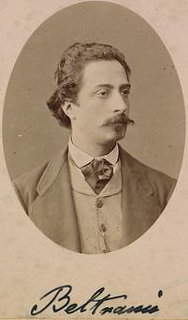Eugenio Beltrami
Eugenio Beltrami (born November 16, 1835 in Cremona , † February 18, 1900 in Rome ) was an Italian mathematician .
Life
Beltrami was a student of Enrico Betti , Francesco Brioschi and Luigi Cremona and obtained his title of railway engineer at the University of Pavia in 1856 . After a short work as railway secretary in Verona and Milan , he resumed his scientific career by staying at the astronomical observatory in Brera . In 1862 he published his first work and in 1864 became a professor in Pisa . Further stations of his professorship were Bologna , Rome, Pavia , and then again Rome. In 1898 he was elected President of the renowned Accademia dei Lincei .
In the first half of his scientific life, Beltrami dealt exclusively with differential geometry and made important contributions. In his Ricerche di analisi applicata alla Geometria there is for the first time a complete description of the "absolute functions" that remain unchanged when a surface is bent. Carl Friedrich Gauß gave a first hint here with his curvature . This work initiated the later development of the topology . Julius Weingarten later referred to the absolute functions as "bending invariants".
In 1868 he gave a concrete model of a non-Euclidean geometry . This model is based on a so-called pseudosphere , i. H. a saddle surface of constant Gaussian curvature. A pseudosphere is created by the rotation of a tractrix around its asymptote.
In the second half of his career, Beltrami worked in the field of mathematical physics , namely in optics , thermodynamics , elasticity theory , potential theory and electromagnetism . He paid particular attention to the possible reformulation of basic physical laws for spaces with negative curvature and, among other things, formulated a generalized version of the Laplace operator . The Beltrami equation is of fundamental importance in the theory of quasi-conformal mapping. The complex dilatation is also referred to there as the Beltrami coefficient.
In 1875 he was elected a member of the Göttingen Academy of Sciences . From 1881 he was a corresponding member of the Prussian and from 1899 of the Bavarian Academy of Sciences . In 1890 he was accepted as a corresponding member of the Académie des sciences .
Others
The Italian glyptist Giovanni Beltrami (gem cutter) was the grandfather of Eugenio Beltrami.
literature
- Karl-Eugen Kurrer : The History of the Theory of Structures. Searching for Equilibrium . Ernst & Sohn , Berlin 2018, p. 793 a. S. 968 (biography), ISBN 978-3-433-03229-9 .
Web links
- John J. O'Connor, Edmund F. Robertson : Eugenio Beltrami. In: MacTutor History of Mathematics archive .
- Link to Collected Works at gallica
- https://www.encyclopedia.com/people/science-and-technology/mathematics-biographies/eugenio-beltrami
Individual evidence
- ^ Tadeusz Iwaniec, Gaven Martin: The Beltrami equation. In: Memoirs of the American Mathematical Society. Volume 191, No. 893, 2008.
- ↑ Holger Krahnke: The members of the Academy of Sciences in Göttingen 1751-2001 (= Treatises of the Academy of Sciences in Göttingen, Philological-Historical Class. Volume 3, Vol. 246 = Treatises of the Academy of Sciences in Göttingen, Mathematical-Physical Class. Episode 3, vol. 50). Vandenhoeck & Ruprecht, Göttingen 2001, ISBN 3-525-82516-1 , p. 35.
- ^ Members of the previous academies. Eugenio Beltrami. Berlin-Brandenburg Academy of Sciences and Humanities , accessed on February 20, 2015 .
- ↑ Member entry of Eugenio Beltrami (with a link to an obituary) at the Bavarian Academy of Sciences , accessed on January 5, 2017.
- ^ List of members since 1666: Letter B. Académie des sciences, accessed on September 17, 2019 (French).
| personal data | |
|---|---|
| SURNAME | Beltrami, Eugenio |
| BRIEF DESCRIPTION | Italian mathematician |
| DATE OF BIRTH | November 16, 1835 |
| PLACE OF BIRTH | Cremona |
| DATE OF DEATH | February 18, 1900 |
| Place of death | Rome |
